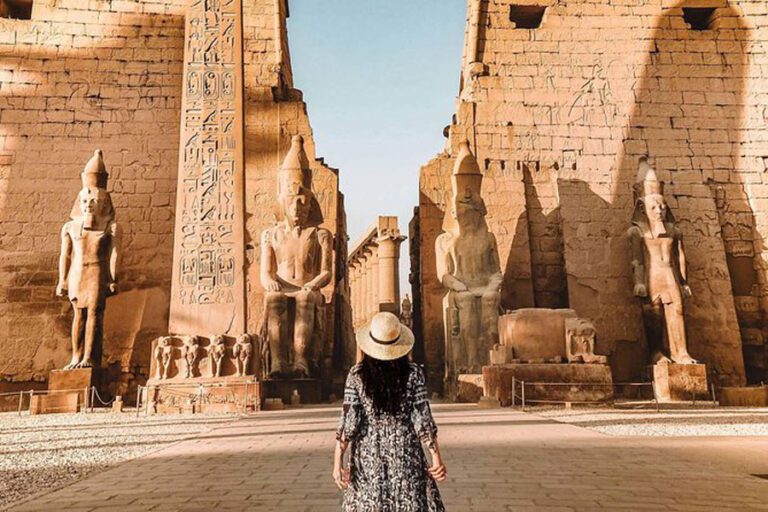Explore the Ancient Wonders of Saqqara: A Journey Through Time
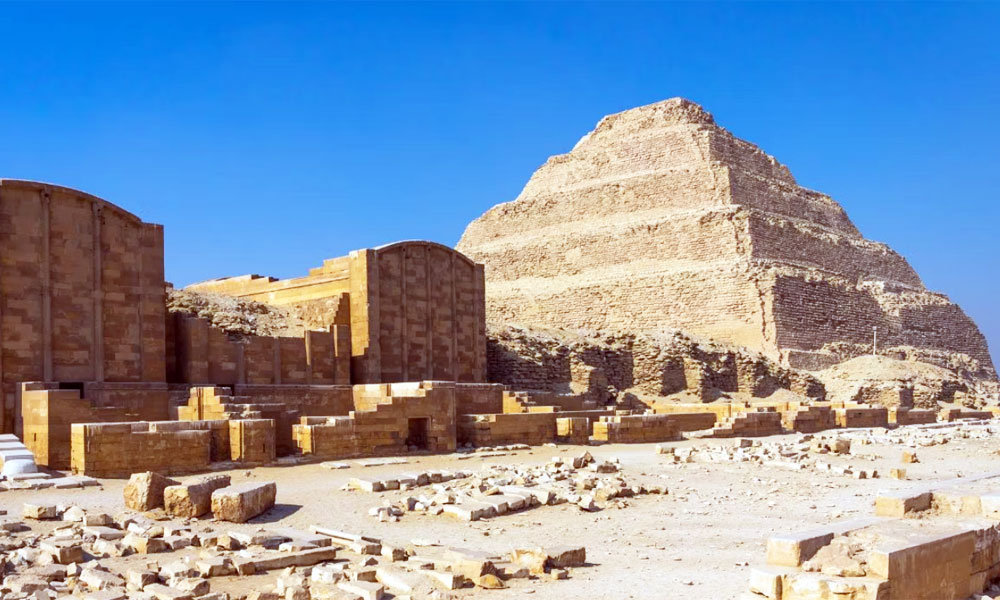
Saqqara is a name that resonates through the ages. Its towering pyramids and ancient ruins have fascinated travelers and scholars alike for centuries, drawing visitors from all over the world to explore its rich history and cultural significance.
This enigmatic site, located on the west bank of the Nile River in Egypt, is home to some of the most awe-inspiring examples of ancient architecture on the planet. From the majestic Step Pyramid of Djoser to the mysterious Pyramid of Unas, Saqqara is a place where the past comes alive and the mysteries of ancient Egypt are revealed.
Significance of Saqqara in Ancient Egypt
For ancient Egyptians, Saqqara was a place of great importance. This was the site of Memphis, the capital of Egypt for over two millennia, and a center of political, religious, and cultural activity. It was also the necropolis of Memphis, a vast burial ground where pharaohs, nobles, and officials were interred in grand tombs and pyramids.
The site’s strategic location on the west bank of the Nile, which was associated with the afterlife, made it an ideal place for the dead to be buried and for the living to connect with their ancestors.
In this blog post, we will explore the ancient wonders of Saqqara and take a journey through time to discover the rich history and cultural significance of this fascinating site. We will delve into the mysteries of the Step Pyramid of Djoser, the unique shape of the Bent Pyramid, the grandeur of the Red Pyramid, the beauty of the Pyramid of Teti, and the inscriptions of the Pyramid of Unas.
With each pyramid, we will uncover the secrets of the pharaohs and their quest for immortality, and gain a deeper understanding of the role that Saqqara played in the development of ancient Egyptian civilization. So, let us embark on a journey through time and explore the ancient wonders of Saqqara.
The Step Pyramid of Djoser
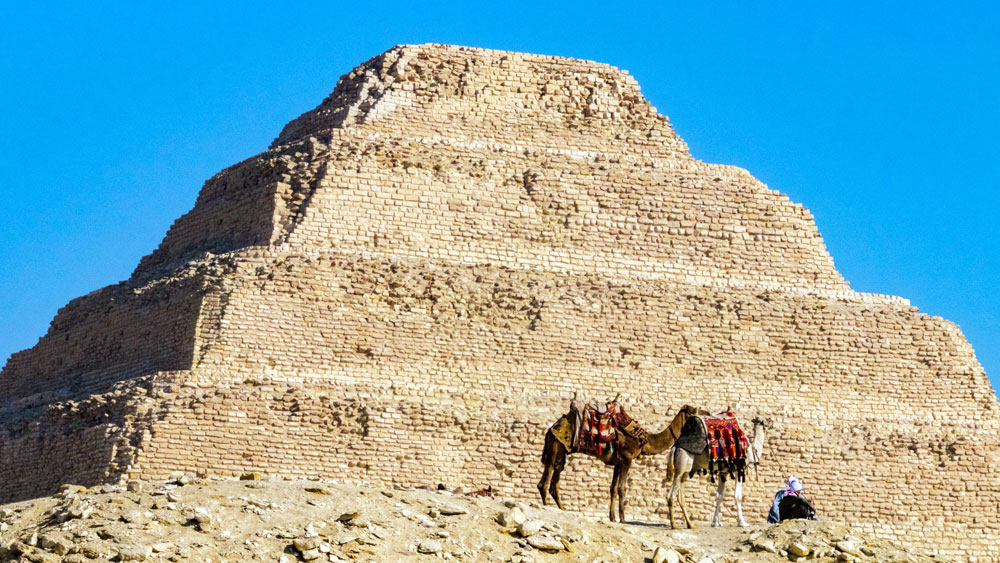
Brief History and Construction
The Step Pyramid of Djoser is one of the most iconic structures in Saqqara, and indeed in all of Egypt. Built in the 27th century BCE during the Third Dynasty by the architect Imhotep, it was the first pyramid ever constructed, and a groundbreaking achievement in ancient architecture.
Djoser’s pyramid was originally designed as a mastaba, a flat-roofed, rectangular structure with sloping sides. However, Imhotep, a true visionary, decided to stack six mastabas on top of each other, creating the first-ever pyramid with steps. This innovative design not only made the Step Pyramid of Djoser stand out, but it also paved the way for the construction of larger, more complex pyramids in the centuries to come.
Features and Significance
The Step Pyramid of Djoser is a marvel of ancient engineering and design. The pyramid itself stands 203 feet (62 meters) tall and is made up of six distinct levels, each decreasing in size as it ascends. Its base measures approximately 410 feet (125 meters) by 358 feet (109 meters), and it’s surrounded by a massive enclosure wall, which originally measured over 33 feet (10 meters) tall.
The pyramid is also notable for its distinctive T-shaped entrance, which leads into a labyrinthine series of corridors, chambers, and galleries. This complex internal structure is thought to have held Djoser’s mummified remains, along with countless treasures and offerings for the afterlife.
The significance of the Step Pyramid of Djoser cannot be overstated. This pyramid marked a turning point in the evolution of ancient Egyptian architecture and religion. It also symbolized the power and prestige of the pharaohs, who saw the construction of these grand monuments as a way to ensure their immortality and link their legacy to the gods.
The Step Pyramid of Djoser is a testament to the ingenuity and creativity of ancient Egyptians and a must-see for anyone interested in ancient history and architecture.
The Bent Pyramid
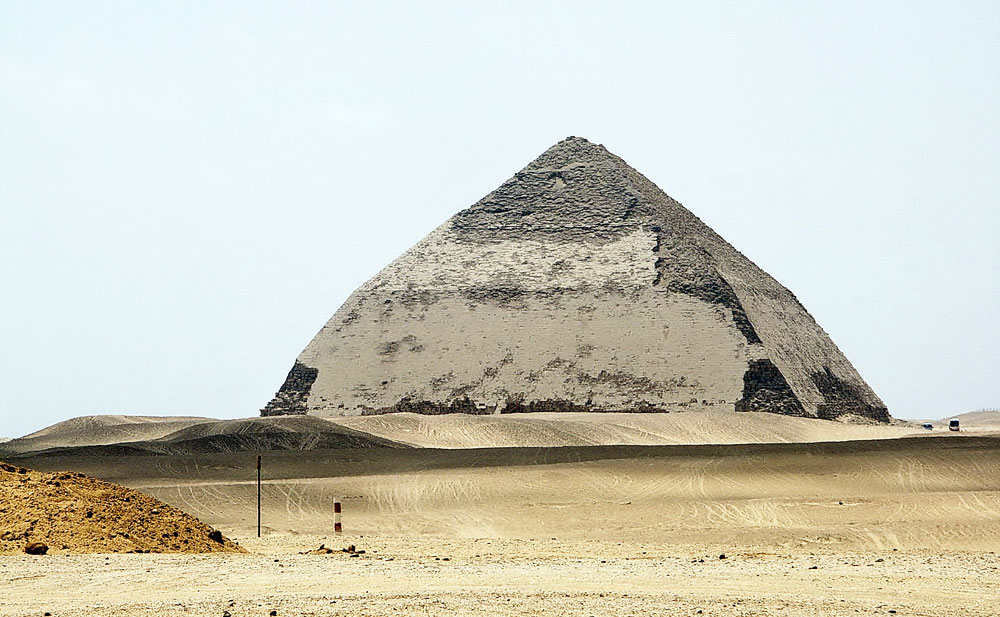
Brief History and Construction
The Bent Pyramid is one of the most distinctive and intriguing structures in Saqqara, and indeed in all of Egypt. Built during the reign of the pharaoh Sneferu in the 26th century BCE, it is one of the earliest examples of a true pyramid, with smooth, sloping sides rising to a point at the top.
However, what makes the Bent Pyramid truly unique is its unusual shape. Originally, the pyramid was constructed with a steep angle of 54 degrees, but halfway through the building process, the architects realized that the structure was unstable and had to change course. As a result, they adjusted the angle to a gentler slope of 43 degrees, resulting in the pyramid’s distinctive “bent” shape.
Unique Shape and Features
The Bent Pyramid is an architectural wonder that continues to fascinate visitors to this day. Its unique shape gives it a striking appearance, with the upper portion of the pyramid appearing to be set at a different angle than the lower portion. The structure stands at 331 feet (101 meters) tall and has a base of approximately 620 feet (189 meters) by 617 feet (188 meters).
Like other pyramids in Saqqara, the Bent Pyramid has an elaborate internal structure, with numerous chambers and corridors designed to hold the pharaoh’s mummified remains and treasures.
One of the most interesting features of the Bent Pyramid is its unusual entrance, which is located on the north face of the pyramid, rather than on the usual east face. The entrance leads into a descending corridor that eventually opens up into a large burial chamber. This chamber is notable for its vaulted ceiling which is made up of rows of stone beams that converge at the center of the room.
Significance in the Development of Pyramid Architecture in Egypt
The Bent Pyramid is a significant milestone in the development of pyramid architecture in ancient Egypt. It represents the culmination of several centuries of experimentation and innovation in pyramid design as architects and builders sought to perfect the form and function of these massive structures.
The Bent Pyramid’s unique shape and unusual entrance are evidence of the challenges and risks that these ancient engineers faced as they sought to create ever more grand and imposing monuments to the pharaohs.
Moreover, the Bent Pyramid represents an important transition from the step pyramid to the true pyramid form. This transition was not always smooth, as evidenced by the pyramid’s bent shape, but it marked a significant advancement in the sophistication and complexity of ancient Egyptian architecture.
Without the innovations and experiments of structures like the Bent Pyramid the grand monuments of Giza and beyond may never have been possible.
The Bent Pyramid is a must-see destination that offers a memorable travel experience for history buffs, architecture enthusiasts, and all those seeking unique adventures.
The Red Pyramid
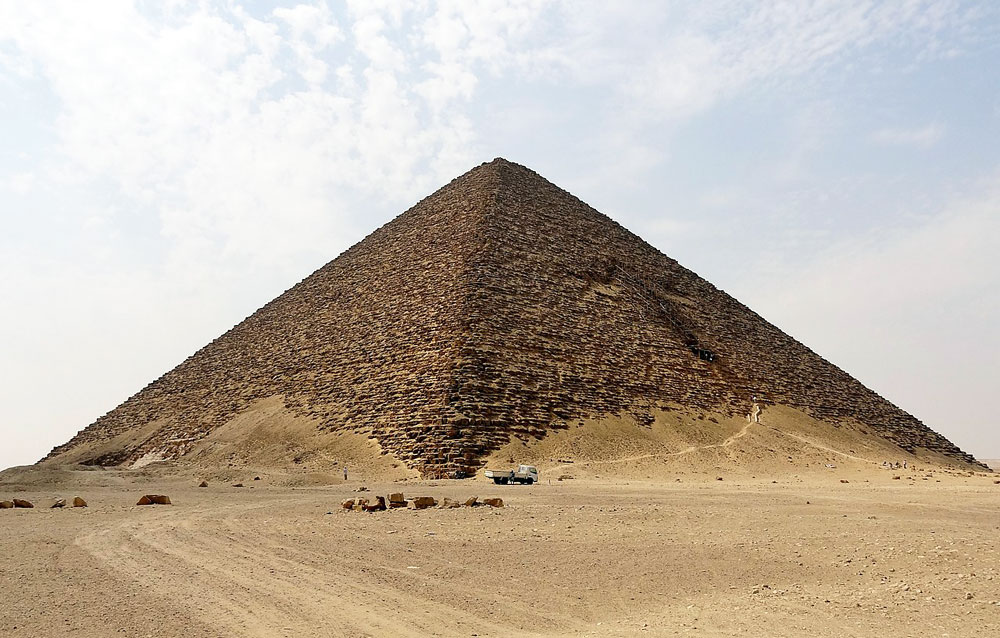
Brief History and Construction
The Red Pyramid is one of the most impressive and well-preserved pyramids in Saqqara dating back to the reign of the pharaoh Sneferu in the 26th century BCE. It is also known as the North Pyramid due to its location and it is the third largest pyramid in Egypt standing at 341 feet (104 meters) tall.
The Red Pyramid gets its name from the reddish hue of the limestone blocks that were used to construct the pyramid’s core. The construction of this pyramid was a massive undertaking with an estimated workforce of over 100,000 people. It was built with smooth, sloping sides rising to a point at the top similar to the Bent Pyramid but with a more gradual angle of 43 degrees.
This pyramid’s impressive size and precise construction are a testament to the ancient Egyptians’ mastery of engineering and their unwavering devotion to honoring their pharaohs.
Features and Significance
The Red Pyramid is an architectural marvel, boasting a number of impressive features that set it apart from other pyramids in Saqqara. One of its most notable features is the pyramid’s entrance, which is located on the north face and leads to a descending corridor that eventually opens up into a series of chambers, including a burial chamber where the pharaoh’s remains were laid to rest.
The interior of the pyramid is also notable for its intricate ventilation system, which helped to regulate the temperature and humidity inside the pyramid and ensure the preservation of the pharaoh’s remains.
It is also significant for its place in Egyptian history. It is the first true pyramid in Egypt and a major milestone in the development of pyramid architecture. It also marked a turning point in the relationship between the pharaoh and the gods, as the pharaoh’s journey to the afterlife was now more closely tied to the pyramid itself, rather than the nearby mortuary temple.
Comparison with the Bent Pyramid and Other Pyramids in Saqqara
The Red Pyramid is often compared to the nearby Bent Pyramid, as both structures were built by Sneferu and represent important milestones in the development of pyramid architecture. However, the two structures differ significantly in their design and construction.
The Bent Pyramid’s unique shape and unusual entrance set it apart from other pyramids in Saqqara, while the Red Pyramid’s smooth, sloping sides and precise construction make it one of the most impressive and well-preserved pyramids in all of Egypt.
In comparison to other pyramids in Saqqara, the Red Pyramid is notable for its size and scale. It is the third largest pyramid in Egypt, behind only the Great Pyramid of Giza and the Pyramid of Khafre. Its impressive height and size are a testament to the ancient Egyptians’ commitment to honoring their pharaohs and the gods.
In summary, the Red Pyramid is a must-see destination in Saqqara for anyone interested in ancient Egyptian history and architecture. Its impressive size and scale, as well as its intricate internal structure, make it one of the most significant and well-preserved pyramids in all of Egypt.
The Pyramid of Teti
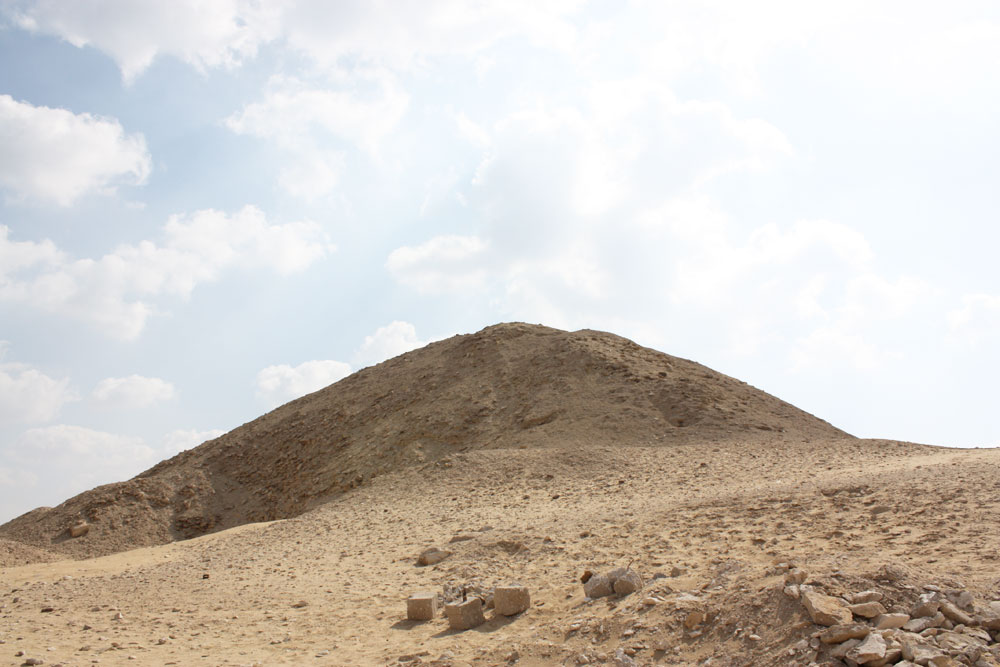
Brief History and Construction
The Pyramid of Teti dates back to the reign of the pharaoh Teti in the 23rd century BCE. It was the first pyramid to be built with text on the walls of the burial chamber including the famous Pyramid Texts that were used to guide the pharaoh’s journey to the afterlife.
The pyramid stands at a height of 170 feet (52 meters) and was built with a more traditional design, with smooth, sloping sides that rise to a point at the top.
The construction of the Pyramid of Teti was a massive undertaking, with an estimated workforce of over 20,000 people. The pyramid was built with limestone blocks, which were quarried from nearby sites and transported to Saqqara.
The precision and care with which the pyramid was constructed are a testament to the ancient Egyptians’ mastery of engineering and their devotion to their pharaohs.
Features and Significance
The Pyramid of Teti is notable for its impressive internal structure including a descending corridor that leads to a burial chamber where the pharaoh’s remains were laid to rest. The burial chamber is adorned with intricate carvings and hieroglyphs including the famous Pyramid Texts, which were used to guide the pharaoh’s journey to the afterlife.
The pyramid is also home to a number of other chambers and passages, including a serdab, where the pharaoh’s statue was placed to receive offerings. It is the first pyramid to be built with text on the walls of the burial chamber.
The Pyramid Texts are some of the oldest religious texts in the world and provide invaluable insight into ancient Egyptian beliefs and practices. The pyramid is also significant for its architectural features, including the descending corridor and other internal structures, which set it apart from other pyramids in Saqqara.
Whether you’re a history buff, an architecture enthusiast, or simply someone looking for an unforgettable travel experience, the Pyramid of Teti and the surrounding structures at Saqqara are a must-visit destination.
The Pyramid of Unas
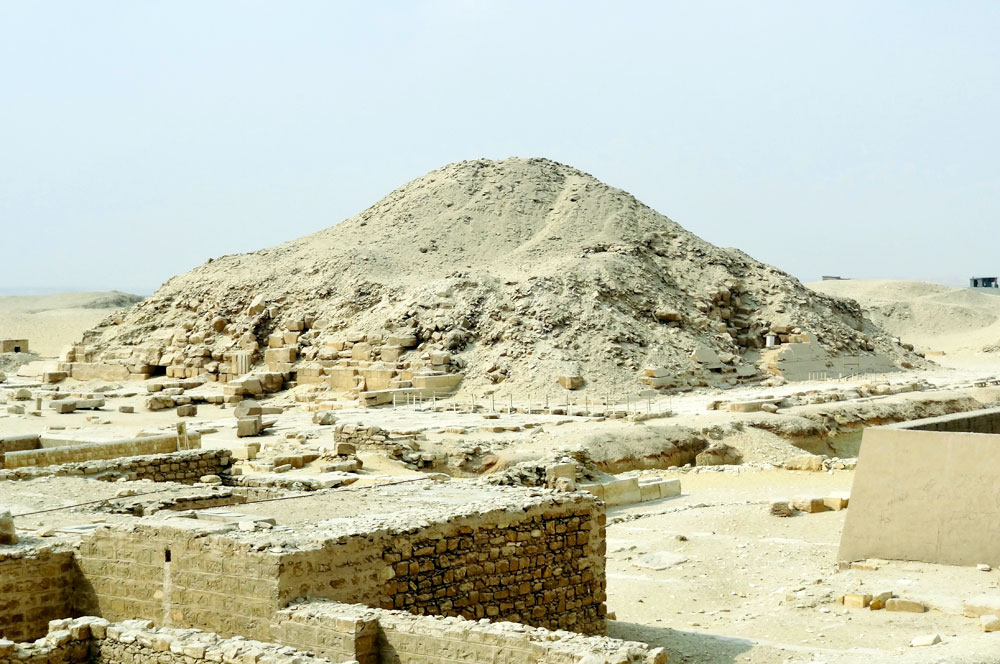
Brief History and Construction
The Pyramid of Unas is located at the southern end of the Saqqara necropolis and is the smallest of the pyramids built during the Old Kingdom era. It was constructed for King Unas, the last pharaoh of the 5th dynasty. The pyramid was built around 2375 BC and is believed to have been completed within a short period of time.
The Pyramid’s Features and Significance
The Pyramid of Unas has a square base of about 190 feet (58 meters) and a height of approximately 141 feet (43 meters). Like other pyramids in Saqqara, it was originally encased in polished white limestone, which has now largely disappeared.
Despite its size, the Pyramid of Unas is significant because it was the first pyramid to contain the Pyramid Texts, a collection of religious spells and incantations carved on the walls of the burial chamber.
The Pyramid Texts were intended to ensure the pharaoh’s safe journey to the afterlife and his transformation into an eternal deity. The texts contain detailed instructions for the pharaoh’s journey through the underworld, his resurrection, and his accession to the afterlife.
It also contains some of the earliest examples of the use of the title “Son of Ra” by a pharaoh, which became a common title for pharaohs in later periods.
Pyramid Texts and Other Inscriptions at The Site
The Pyramid of Unas is famous for its inscriptions of the Pyramid Texts, which cover the walls and ceilings of the burial chamber. The texts contain a wealth of information about ancient Egyptian beliefs about the afterlife and the role of the pharaoh in ensuring the continuity of life.
The texts also contain detailed descriptions of the pharaoh’s journey through the underworld, his encounters with various gods and spirits, and his eventual transformation into an eternal deity.
The pyramid is also home to a number of other inscriptions, including scenes from the Book of the Dead, which were added to the pyramid in later periods. It also contains a series of underground chambers, including a serdab where a statue of the pharaoh was placed to allow him to “see” out into the world of the living.
Other structures at the site include a mortuary temple and a causeway that connected the temple to the pyramid.
The Pyramid of Unas may be smaller than some of the other pyramids in Saqqara, but it is of immense significance in the development of pyramid architecture and religious beliefs in ancient Egypt. Its inscriptions of the Pyramid Texts provide a unique glimpse into the beliefs and practices of the ancient Egyptians and continue to fascinate scholars and visitors alike
Conclusion
In conclusion, Saqqara is a vast necropolis located on the west bank of the Nile River, just south of Cairo. It was the burial ground of the ancient Egyptian capital of Memphis and contains some of the most impressive and historically significant structures of the Old Kingdom era. Saqqara was a site of great importance to the ancient Egyptians, and it continues to be a fascinating place for visitors to explore today.
We encourage all readers to consider visiting this incredible site and experiencing its wonders for themselves. Saqqara should be on your list of must-visit destinations, whether you’re fascinated by architecture, religion, or history, or just looking for an exciting and novel experience.
So pack your bags, grab your camera, and set off on a journey through time to explore the ancient wonders of Saqqara. You won’t be disappointed!






